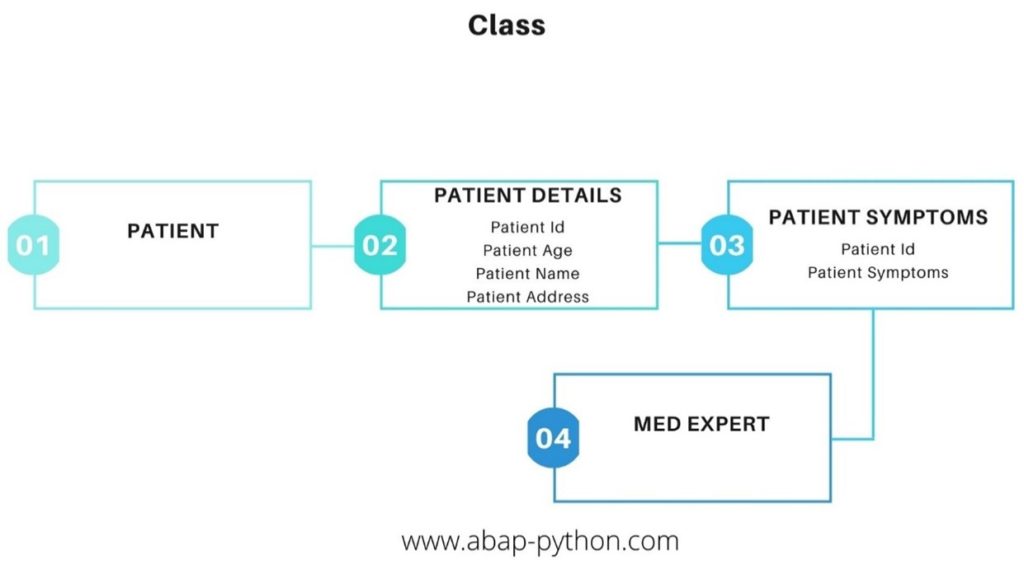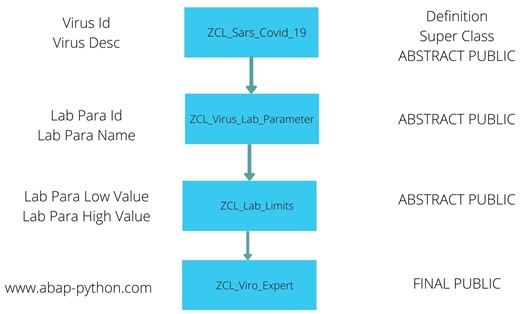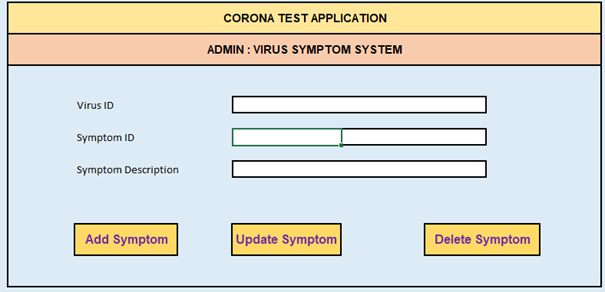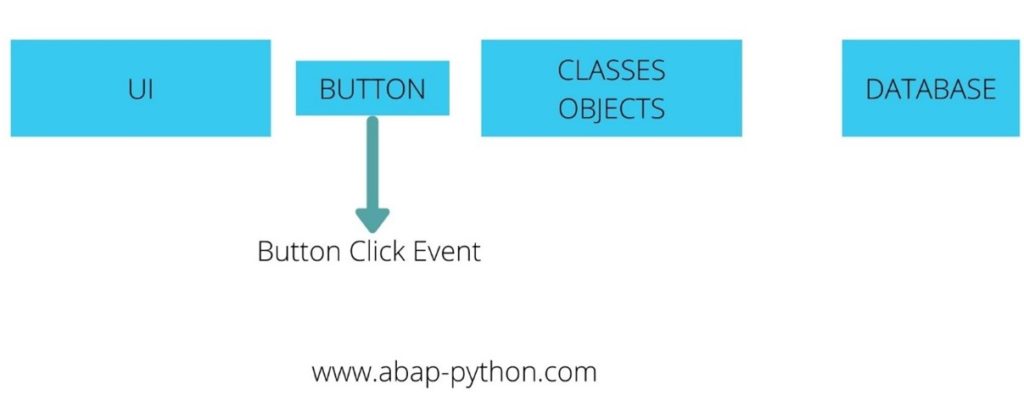Introduction:
This Corona test application is used to test the critical values of the patient. With the help of this application, one can figure out if the patient has Corona Virus. The critical laboratory parameters of the Corona Virus are controlled using the Administrator user interface. The virus details can also be stored in this application. The corona virus symptoms and the patient symptoms are compared in this program. The patient personal details are also entered in this Application.
Data Dictionary:
The first and foremost step in building any application is understanding the type of data involved in the program. The corona virus must be differentiated from other types of virus. Each virus is unique, and it needs to be differentiated using an Id and description. The critical Laboratory parameters of the corona virus in the patient are WBC values, … These parameters must be uniquely identified using an Id, name. Its value determines whether the patient has Corona virus. The lower limit and higher limit of the Laboratory parameters are critical in detecting the corona virus. The symptoms of the corona virus are tracked in the symptom Id and description.

It can be uniquely identified using Id number. So every main entity here has an Id. For example, the entities such as virus, symptom, patient has an unique Id. The following table shows the properties of each entity.
| Virus | Symptom | Patient | Virus lab parameter |
| Virus Id Virus Description | Symptom Id Symptom Description | Patient Id Patient name Patient age Patient address | Parameter Id Parameter name Parameter Critical values |
We have successfully identified the critical data in our corona test application. Now we have to Build the ABAP Data Dictionary using the critical data.
Let us create the following Data elements.
- Virus entity
- Virus Id – ZDE_Virus_Id – > Datatype – Numc03
- Virus Description – ZDE_Virus_desc -> Datatype – String
- Virus Symptoms
- Symptom Id – ZDE_Symptom_Id – Domain -> Numc03 Datatype
- Symptom Description – ZDE_Symptom_desc -> Datatype – String
- Patient Entity
- Patient Id – ZDE_Patient_Id -> Datatype – Numc03
- Patient Age – ZDE_Patient_age -> Datatype – Numc02
- Patient Name – ZDE_Patient_name -> Datatype – String
- Patient Address – ZDE_Patient_address -> Datatype – String
- Virus Lab Parameter
- Parameter Id – ZDE_Parameter_Id -> Datatype – Numc03
- Parameter name – ZDE_Parameter_name -> Datatype – String
Let us now create the following Data tables.
- ZTT_Virus_DB => Data table
Field 1 à Virus_Id => ZDE_Virus_Id
Field 2 à Virus_description => ZDE_Virus_desc
- ZTT_Symptoms => Data table
Field 1 à Symptom_Id => ZDE_Symptom_Id
Field 2 à Symptom_description => ZDE_Symptom_desc
- ZTT_Patient => Data table
Field 1 àPatient_Id => ZDE_Patient_Id
Field 2 à Patient_name => ZDE_Patient_name
Field 3 à Patient_age => ZDE_Patient_age
Field 4 à Patient_address => ZDE_Patient_address
- ZTT_Lab_Parameter => Data table
Field 1 àLab_para_Id => ZDE_lab_para_Id
Field 2 à Lab_para_name => ZDE_lab_para_name
Field 3 à Lab_para_low_value => ZDE_lab_para_low_value
Field 4 à Lab_para_high_value => ZDE_lab_para_high_value
Object oriented Branch details
I. First branch
First Branch in creating the object-oriented model for corona test application.

II. Second Branch
Second branch in the corona test application for the corona symptoms.

III. Third Branch
Third Branch in the corona test application for the patient details.

IV. Fourth Branch
Fourth Branch for the patient lab test values.

Description of Interfaces and methods.
Interface: One of the key concepts which can be considered as the Skeleton of the object oriented model. Let us consider the following interfaces to implement the corona test application.
- ZIF_VIR_DETAILS
- ZIF_LAB_ATTRIBUTE_NAME
- ZIF_LAB_ATTRIBUTE_VALUE
- ZIF_SYMPTOMS
- ZIF_PATIENT
Now, Let us look at the definition of each Interfaces.
- INTERFACE zif_vir_details
PUBLIC.
METHODS set_vir_details
IMPORTING i_virus_id TYPE zde_virus_id
i_virus_desc TYPE zde_virus_desc.
METHODS get_vir_details
IMPORTING i_virus_id TYPE zde_virus_id
EXPORTING e_virus_desc TYPE zde_virus_desc.
ENDINTERFACE.
- INTERFACE zif_lab_attribute_name
PUBLIC .
METHODS set_attribute_name
IMPORTING i_lab_attribute_name TYPE zde_parameter_name
i_lab_attribute_id TYPE zde_parameter_id
i_virus_id TYPE zde_virus_id.
METHODS get_attribute_name
IMPORTING i_lab_attribute_id TYPE zde_parameter_id
i_virus_id TYPE zde_virus_id
EXPORTING e_lab_attribute_name TYPE zde_paramete_name.
ENDINTERFACE.
- INTERFACE zif_lab_attribute_value
PUBLIC.
METHODS set_lab_attribute_value
IMPORTING i_lab_attribute_id TYPE zde_parameter_id
i_virus_id TYPE zde_virus_id
i_lab_para_low_value TYPE ZDE_lab_para_low_value
i_lab_para_high_value TYPE ZDE_lab_para_high_value.
METHODS get_lab_attribute_value
IMPORTING i_lab_attribute_id TYPE zde_parameter_id
EXPORTING e_lab_para_value TYPE int4
ENDINTERFACE.
- INTERFACE ZIF_SYMPTOMS
PUBLIC.
METHODS set_symptoms
IMPORTING i_symptom_id TYPE zde_symptom_id
i_symptom_desc TYPE zde_symptom_desc.
METHODS get_symptoms.
EXPORTING et_symptoms TYPE ztt_symptom_ty.
ENDINTERFACE.
INTERFACE zif_patient
PUBLIC.
METHODS set_patient_details
IMPORTING i_patient_id TYPE zde_patient_id
i_patient_name TYPE zde_patient_name
i_patient_age TYPE num02
i_patient_address TYPE zde_patient_address.
METHODS get_patient_details
IMPORTING i_patient_id TYPE zde_patient_id
EXPORTING e_patient_name TYPE zde_patient_name
e_patient_age TYPE num02
e_patient_address TYPE zde_patient_address.
METHODS set_patient_symptoms
IMPORTING i_symptom_desc TYPE zde_symptom_desc
i_patient_id TYPE zde_patient_id.
METHODS get_patient_symptoms.
IMPORTING i_patient_id TYPE zde_patient_id
EXPORTING et_symptom_desc TYPE ztt_symptom_desc.
METHODS set_patient_lab para_values.
IMPORTING i_patient_id TYPE zde_patient_id
i_lab_para_id TYPE zde_parameter_id
i_lab_para_value TYPE int4.
METHODS get_patient_lab_para_values.
IMPORTING i_patient_id TYPE zde_patient_id
i_lab_para_id TYPE zde_parameter_id
EXPORTING e_lab_para_value TYPE int4.
ENDINTERFACE.
Now we have discussed about the data, Data tables, Object branches, skeleton of the system (Interface).

User Interface
The front end helps us to understand the whole process easily. So lets begin with the user interface for the virology expert team.
User Interface for Virology expert Team

Figure 1 Admin User Interface
The user interface depicts the input elements of the virus information systems. The data which is entered in these textboxes, must be stored in the Database.

Classes and objects
The data from the user interface elements are passed through the classes and objects. These Sar_Covid 19, virus lab parameters, lab limits objects carry the data from the user interface and insert the data into the database. The very next step would be to create objects. Now we will investigate the creation of these classes. We discussed about the different object oriented branches in the beginning. Now we will look in detail about the code for each of these branches.
Picture below depicts the different classes between the UI and Database.

Figure 2 Virus Branch
First Object oriented branch for virus data

Now let’s see the code directly in the above classes.
a) zcl_Sars_Covid_19
CLASS zcl_sars_covid_19 DEFINITION
PUBLIC
ABSTRACT CREATE PUBLIC.
PUBLIC SECTION.
INTERFACES zif_vir_details.
INTERFACES zif_lab_attribute_name.
INTERFACES zif_lab_attributevalue.
INTERFACES zif_symptoms.
METHODS constructor
IMPORTING i_virus_id TYPE zde_virus_id
i virus_desc TYPE zdevirusdesc.
PROTECTED SECTION.
DATA m_virus_id TYPE zde_virus_id.
DATA m_virus_desc TYPE zde_virusdesc.
PRIVATE SECTION.
ENDCLASS.
CLASS zcl_sars_covid_19 IMPLEMENTATION.
METHOD constructor.
m_virus_id = i_virus_id.
m_virus_desc = i_virus_desc.
ENDMETHOD.
METHOD zif_vir_details~set_vir_details.
ENDMETHOD.
METHOD zif_virdetails~getvirdetails.
ENDMETHOD.
METHOD zif_labattribute_name~set_attribute_name.
ENDMETHOD.
METHOD zif_lab_attribute_name~get_attributename.
ENDMETHOD.
METHOD zif_lab_attribute_value-set_lab_attribute_value.
ENDMETHOD.
METHOD zif_lab_attribute_value~get_lab_attributevalue.
ENDMETHOD.
METHOD zif_symptoms~set_symptoms.
ENDMETHOD.
METHOD zif_symptoms~get_symptoms.
ENDMETHOD.
ENDCLASS.
b) zcl_virus_lab_parameters
CLASS zcl_virus_lab_parameters DEFINITION INHERITING FROM zcl_sars_covid_19
PUBLIC ABSTRACT
CREATE PUBLIC.
PUBLIC SECTION.
METHODS zif_lab_attribute_name~set_attribute_name REDEFINITION. METHODS zif_lab_attribute_name~get_attribute_name REDEFINITION. METHODS constructor
IMPORTING i_virus_id TYPE zde_virus_id
i_virus_desc TYPE zde_virus_desc
i_lab_para_id TYPE zde_lab_para_id
i_lab_para_name TYPE zde_lab_para_name.
PROTECTED SECTION.
DATA m_lab_para_id TYPE zde_lab_para_id.
DATA m_lab_para_name TYPE zde_lab_para_name.
PRIVATE SECTION.
ENDCLASS.
CLASS zcl_virus_lab_parameters IMPLEMENTATION.
METHOD constructor.
super->constructor( i_virus_id = i_virus_id
i_virus_desc = i_virus_desc ).
m_lab_para_id = i_lab_para_id.
m_lab_para_name = i_lab_para_name.
ENDMETHOD.
METHOD zif_lab_attribute_name~set_attribute_name.
DATA lt_lab_parameters TYPE STANDARD TABLE OF ztt_lab_para.
DATA ls_lab_parameters LIKE LINE OF lt_lab_parameters.
ls_lab_parameters-parameter_id = i_lab_attribute_id.
ls_lab_parameters-parameter_name = i_lab_attribute_name.
ls_lab_parameters-virus_id = i_virus_id.
SELECT SINGLE * FROM ztt_lab_para INTO ls_lab_parameters WHERE
parameter_id = i_lab_attribute_id.
IF sy-subrc <> O.
INSERT INTO ztt_lab_para VALUES ls_lab_parameters.
ENDIF.
ENDMETHOD.
METHOD zif_lab_attribute_name~get_attribute_name.
DATA lt_lab_parameters TYPE STANDARD TABLE OF ztt_lab_para.
FIELD-SYMBOLS <fs_param> LIKE LINE OF lt_lab_parameters.
SELECT * FROM ztt_lab_para INTO TABLE lt_lab_parameters WHERE
Parameter_id = i_lab_attribute_id AND virus id = i_virus_id.
IF sy-subrc = 0.
READ TABLE lt_lab_parameters INDEX 1 ASSIGNING <fs_param>.
IF sy-subrc = 0.
e_lab_attribute_name = <fs_param>-parameter_name.
ENDIF.
ENDIF.
ENDMETHOD.
ENDCLASS.
c) Zcl_lab_limits
CLASS zcl_lab_limits DEFINITION INHERITING FROM zcl_virus_lab_parameters
PUBLIC ABSTRACT
CREATE PUBLIC .
PUBLIC SECTION.
METHODS zif_lab_attribute_value~set_lab_attribute_value REDEFINITION. METHODS zif_lab_attribute_value~get_lab_attribute_value REDEFINITION. METHODS constructor
IMPORTING i_virus_id TYPE zde_virus_id
i_virus_desc TYPE zde_virus_desc
i_lab_para_id TYPE zde_parameter_id
i_lab_para_name TYPE zde_parameter_name
i_lab_para_low_value TYPE int4
i_lab_para_high_value TYPE int4.
PROTECTED SECTION.
DATA m_lab_para_low_value TYPE int4.
DATA m_lab para_bigh_value TYPE int4.
PRIVATE SECTION.
ENDCLASS.
CLASS zcl_lab_limits IMPLEMENTATION.
METHOD constructor.
super->constructor( i_virus_id = i_virus_id
i_virus_desc = i_virus_desc
i_lab_para_id = i_lab_para_id
i_lab_para_name = i_lab_para_name).
m_lab_para_low_value = i_lab_para_low_value.
m_lab_para_high_value = i_lab_para_high_value.
ENDMETHOD.
METHOD zif_lab_attribute_value~set_lab_attribute_value.
DATA lt_lab_para_values TYPE STANDARD TABLE OF ztt_lab_para_val. DATA lt_lab_para_values LIKE LINE OF lt_lab_para_values.
DATA lt_lab_para TYPE STANDARD TABLE OF ztt_lab_para.
DATA ls_lab_para LIKE LINE OF lt_lab_para.
SELECT SINGLE * FROM ztt_lab_para INTO Is_lab_para WHERE
parameter_id = i_lab_attribute_id.
IF sy-subrc = 0.
is_lab_para_values-parameter_name = ls_lab_para-parameter_name. is_lab_para_values-parameter_id = ls_lab_para-parameter_id. is_lab_para_values-para_low_value = i_lab_para_low_value. ls_lab_para_values-para_high_value = i_lab_para_high_value.
ENDIF.
INSERT INTO ztt_lab_para_val VALUES lt_lab_para_values. ENDMETHOD.
METHOD zif_lab_attribute_value~get_lab_attribute_value.
DATA lt_lab_para_values TYPE STANDARD TABLE OF ztt_lab_para_val. FIELD-SYMBOLS <fs_param> LIKE LINE OF lt_lab_para_values.
SELECT * FROM ztt_lab_para_val INTO TABLE lt_lab_para_values
WHERE parameter_id = i_lab_attribute_id.
IF sy-subrc = 0.
READ TABLE lt_lab_para_values INDEX 1 ASSIGNING <fs_param>.
IF sy-subrc = 0.
e_lab_para_low_value = <fs_param>-para_low_value. e_lab_para_high_value = <fs_param>-para_high_value.
ENDIF.
ENDIF.
ENDMETHOD.
ENDCLASS.
d) Zcl_viro_expert
CLASS zcl_viro_expert DEFINITION INHERITING FROM zcl_lab_limits
PUBLIC FINAL
CREATE PUBLIC .
PUBLIC SECTION.
METHODS zif_vir_details~set_vir_details REDEFINITION.
METHODS zif_vir_details~get_vir_details REDEFINITION.
METHODs constructor
IMPORTING i_virus_id TYPE zde_virus_id
i_virus_desc TYPE zde_virus_desc
i_lab_para_id TYPE zde_parameter_id
i_lab_para_name TYPE zde_parameter_name
i_lab_para_low value TYPE int4
i_lab_para_high_value TYPE int4.
METHODS set_all_virus_values.
PROTECTED SECTION.
PRIVATE SECTION.
ENDCLASS.
CLASS zcl_viro_expert IMPLEMENTATION.
METHOD constructor.
super->constructor( i_virus_id= i_virus_id
i_virus_desc = i_virus_desc
i_lab_para_id = i_lab_para_id
i_lab_para_name = i_lab_para_name
i_lab_para_low_value = i_lab_para_low_value
i_lab_para_high_value = i_lab_para_high_value ).
ENDMETHOD.
METHOD set_all_virus_values.
zif_vir_details~set_vir_details( i_virus_id = m_virus_id
i_virus_desc = m_virus_desc ).
zif_lab_attribute_name~set_attribute_name(
i_lab_attribute_id = m lab_para_id
i_lab_attribute_name = m_lab_para_name
i_virus_id = m_virus_id ).
zif_lab_attribute_value~set_lab_attribute_value(
i_lab_attribute_id = m_lab_para_id
i_virus_id = m virus_id
i_lab_para_low value = m_lab_para_low_value
i_lab_para_high_value = m_lab_para_high_value ).
ENDMETHOD.
METHOD zif_vir_details~set_vir_details.
DATA lt_virus TYPE STANDARD TABLE OF ztt_virus_db.
DATA is_virus LIKE LINE OF lt_virus.
is_virus-virus_id = i_virus_id.
ls_virus-virus_desc = i_virus_desc.
SELECT * FROM ztt_virus_db INTO table lt_virus WHERE virus_id = i_virus_id.
IF sy-subrc <> 0.
INSERT INTO ztt_virus_db VALUES ls_virus.
ENDIF.
ENDMETHOD.
METHOD zif_vir_details~get_vir_details.
DATA lt_virus_db TYPE STANDARD TABLE OF ztt_virus_db.
FIELD-SYMBOLS <fs_vir> LIKE LINE OF lt_virus_db.
SELECT * FROM ztt_virus_db INTO TABLE lt_virus_db WHERE
virus_id = i_virus_id.
IF sy-subrc = 0.
READ TABLE lt_virus_db ASSIGNING <fs_vir> INDEX 1.
E_virus_desc = <fs_vir>-virus_desc.
ENDIF.
ENDMETHOD.
ENDCLASS.
Second Branch to handle the corona virus symptoms.
| Key Member Variables | Class Hierarchy | Definition |
| Virus_Id Virus_desc | ZCL_Sars_Covid_19 | PUBLIC ABSTRACT |
| Symptom_Id | ZCL_Symptoms | PUBLIC |
| ZCL_Med_Expert | PUBLIC |
a) Zcl_sars_covid_19
This class creation is already discussed in the first branch
b) Zcl_symptoms
CLASS zcl_symptoms DEFINITION INHERITING FROM zcl_sars_covid_19
PUBLIC
CREATE PUBLIC .
PUBLIC SECTION.
METHODS zif_symptoms~set_symptoms REDEFINITION.
METHODS zif_symptoms~get_symptoms REDEFINITION.
PROTECTED SECTION.
PRIVATE SECTION.
ENDCLASS.
CLASS zcl_symptoms IMPLEMENTATION.
METHOD zif_symptoms~set_symptoms.
DATA it_symptoms TYPE STANDARD TABLE OF ztt_symptom.
DATA is_symptoms LIKE LINE OF lt_symptoms.
SELECT * FROM ztt_symptom INTO TABLE lt_symptoms WHERE virus_id = m_virus_id AND symptom_id = i_symptom_id.
IF sy-subrc <> 0.
ls_symptoms-virus_id = m_virus_id.
ls_symptoms-symptom_id = i_symptom_id.
ls_symptoms-symptom_desc = i_symptom_desc.
INSERT INTO ztt_symptom VALUES ls_symptoms.
ENDIF.
ENDMETHOD.
METHOD zif_symptoms~get_symptoms.
DATA lt_symptoms TYPE STANDARD TABLE OF ztt_symptom.
SELECT * FROM ztt_symptom INTO table lt_symptoms WHERE virus_id = m_virus_id.
LOOP AT lt_symptoms into DATA(ls_symptoms).
APPEND ls_symptoms TO et_symptoms.
ENDLOOP.
ENDMETHOD.
ENDCLASS.
c) Zcl_med _expert
CLASS zcl_med_expert DEFINITION PUBLIC INHERITING FROM zcl_symptoms
FINAL CREATE PUBLIC .
PUBLIC SECTION.
PROTECTED SECTION.
PRIVATE SECTION.
ENDCLASS.
CLASS zcl_med_expert IMPLEMENTATION.
ENDCLASS.
User interface for the corona virus symptoms

Figure 3 Corona Virus Symptoms
Third Branch for patient details and patient corona symptoms
| Key Attributes | Class Hierarchy | Description |
| ZCL_Patient | PUBLIC ABSTRACT | |
| ZCL_Patient_Det | PUBLIC | |
| ZCL_Patient_Symptom | PUBLIC |
- Zcl_patient
CLASS zcl_patient DEFINITION
PUBLIC
abstract
CREATE PUBLIC .
PUBLIC SECTION.
INTERFACES zif_patient.
METHODS constructor.
PROTECTED SECTION.
PRIVATE SECTION.
ENDCLASS.
CLASS zcl_patient IMPLEMENTATION.
METHOD constructor.
ENDMETHOD.
METHOD zif_patient~get_patient_details.
ENDMETHOD.
METHOD zif_patient~get_patient_symptoms.
ENDMETHOD.
METHOD zif_patient~set_patient_details.
ENDMETHOD.
METHOD zif_patient~set_patient_symptoms.
ENDMETHOD.
METHOD zif_patient~set_patient_lab_para_values.
ENDMETHOD.
METHOD zif_patient~get_patient_lab_para_values.
ENDMETHOD.
ENDCLASS.
- Zcl_patient_det
CLASS zcl_patient_det DEFINITION INHERITING FROM zcl_patient
PUBLIC
CREATE PUBLIC .
PUBLIC SECTION.
METHODS zif_patient~set_patient_detalis REDEFINITION.
METHODS zif_patient~get_patient_details REDEFINITION.
PROTECTED SECTION.
PRIVATE SECTION.
ENDCLASS.
CLASS zcl_patient_det IMPLEMENTATION.
METHOD zif_patient~set_patient_details.
DATA it_patient TYPE STANDARD TABLE OF ztt_patient_det.
DATA ls_patient LIKE LINE OF it_patient.
ls_patient-patient_id = i_patient_id.
ls_patient-patient_name = i_patient_name.
ls_patient-patient_age = i_patient_age.
ls_patient-patient_address = i_patient_address.
SELECT * FROM ztt_patient_det INTO TABLE it_patient WHERE patient_id = i_patient_id.
IF sy-subrc <> 0.
INSERT INTO ztt_patient_det VALUES ls_patient.
ENDIF.
ENDMETHOD.
METHOD zif_patient~get_patient_details.
DATA lt_patient TYPE STANDARD TABLE OF ztt_patient_det.
FIELD-SYMBOLS <fs_patient> LIKE LINE OF lt_patient.
SELECT * FROM ztt_patient_det INTO TABLE it_patient WHERE patient_id = i_patient_id.
IF sy-subrc = 0.
READ TABLE it_patient ASSIGNING <fs_patient> INDEX 1.
e_patient_name = <fs_patient>-patient_name.
e_patient_age = <fs_patient>-patient_age.
e_patient_address = <fs_patient>-patient_address.
ENDIF.
ENDMETHOD.
ENDCLASS.

Figure 4 User interface for Patient Details
- Zcl_patient_symptom
CLASS zcl_patient_symptom DEFINITION INHERITING FROM zcl_patient_det
PUBLIC
CREATE PUBLIC .
PUBLIC SECTION.
METHODS zif_patient~set_patient_symptoms REDEFINITION.
METHODS zif_patient~get_patient_symptoms REDEFINITION.
PROTECTED SECTION.
PRIVATE SECTION.
ENDCLASS.
CLASS zcl_patient_symptom IMPLEMENTATION.
METHOD zif_patient~get_patient_symptoms.
DATA lt_patient_sym TYPE STANDARD TABLE OF ztt_patient_sym.
DATA ls_patient_sym LIKE LINE OF lt_patient_sym.
DATA lt_symptom TYPE STANDARD TABLE OF ztt_symptom.
SELECT * FROM ztt_patient_sym INTO TABLE lt_patient_sym WHERE patient_id = i_patient_id.
IF sy-subrc = 0.
LOOP AT lt_patient_sym INTO ls_patient_sym.
SELECT * FROM ztt_symptom INTO TABLE lt_symptom WHERE symptom_id = ls_patient_sym-symptom_id.
LOOP AT lt_symptom INTO DATA(ls_symptom).
APPEND ls_symptom-symptom_desc TO et_symptom_desc.
ENDLOOP.
ENDLOOP.
ENDIF.
ENDMETHOD.
METHOD zif_patient~set_patient_symptoms.
DATA lt_patient_sym TYPE STANDARD TABLE OF ztt_patient_sym.
DATA is_patient_sym LIKE LINE OF lt_patient_sym.
DATA it_symptom TYPE STANDARD TABLE OF ztt_symptom.
DATA 1_max TYPE num02.
SELECT * FROM ztt_symptom INTO TABLE lt_symptom WHERE symptom_desc LIKE i_symptom_desc.
LOOP AT it_symptom INTO DATA(ls_symptom).
ls_patient_sym-patient_id = i_patient_id.
ls_patient_sym-symptom_id = ls_symptom-symptom_id.
SELECT MAX( symptom_record ) INTO 1_max FROM ztt_patient_sym WHERE patient_id = i_patient_id.
ls_patient_sym-symptom_record = 1_max + 01.
INSERT INTO ztt_patient_sym VALUES ls_patient_sym.
ENDLOOP.
ENDMETHOD.
ENDCLASS.

Figure 5 Corona Patient Symptoms
Fourth Branch for Corona patient lab values and corona test
| Key Attributes | Class Name | Definition |
| ZCL_Patient | PUBLIC ABSTRACT | |
| ZCL_Patient_Lab_Values | PUBLIC | |
| ZCL_Corona_Test | PUBLIC FINAL |
- Zcl_patient
This class is already discussed in the third branch
- zcl_patient_lab_values
CLASS zcl_patient_lab_values DEFINITION INHERITING FROM zcl_patient
PUBLIC
CREATE PUBLIC .
PUBLIC SECTION.
METHODS zif_patient~set_patient_lab_para_values REDEFINITION.
METHODS zif_patient~get_patient_lab_para_values REDEFINITION.
PROTECTED SECTION.
PRIVATE SECTION.
ENDCLASS.
CLASS zcL_patient_lab_values IMPLEMENTATION.
METHOD zif_patient~set_patient_lab_para_values.
DATA lt_patient_lab TYPE STANDARD TABLE OF ztt_patient_lab.
DATA ls_patient_lab LIKE LINE OF lt_patient_lab.
ls_patient_lab-patient_id = i_patient_id.
ls_patient_lab-lab_para_id = i_lab_para_id.
ls_patient_lab-pati_lab_para_value = i_lab_para_value.
SELECT * FROM ztt_patient_lab INTO TABLE lt_patient_lab WHERE patient_id = i_patient id AND lab_para_id = i_lab_para_id.
IF sy-subrc <> 0.
INSERT INTO ztt_patient_lab VALUES ls_patient_lab.
ENDIF.
ENDMETHOD.
METHOD zif_patient~get_patient_lab_para_values.
DATA lt_patient_lab TYPE STANDARD TABLE OF ztt_patient_lab.
FIELD-SYMBOLS <fs_patient_lab> LIKE LINE OF lt_patient_lab.
SELECT * FROM ztt_patient_lab INTO TABLE lt_patient_lab WHERE patient_id = i_patient_id AND lab_para_id = i_lab_para_id.
IF sy-subrc = 0.
READ TABLE lt_patient_lab ASSIGNING <fs_patient_lab> INDEX 1.
e_lab_para_value = <fs_patient_lab>-pati_lab_para_value.
ENDIF.
ENDMETHOD.
ENDCLASS.

Figure 6 Patient Lab Values
- Zcl_corona_test
CLASS zcl_corona_test DEFINITION INHERITING FROM zcl_patient_lab_values
PUBLIC
FINAL
CREATE PUBLIC .
PUBLIC SECTION.
METHODS get_patient_object EXPORTING rr_patient TYPE REF TO zif_patient.
METHODS check_patient_symptoms IMPORTING i_patient_id TYPE zde_virus_id EXPORTING e_corona_symptom TYPE abap_bool.
METHODS get_patient_corona_test IMPORTING i_patient_id TYPE zde_virus_id RETURNING VALUE(e_patient_corona_test) TYPE abap_bool.
METHODS check_lab_value IMPORTING i_patient_lab_value TYPE int4 i_lab_para_id TYPE zde_virus_id RETURNING VALUE(r_wbc_critical) TYPE abap_bool.
PROTECTED SECTION.
PRIVATE SECTION.
ENDCLASS.
CLASS zcl_corona_test IMPLEMENTATION.
METHOD get_patient_object.
rr_patient = NEW zcl_patient_symptom( ).
ENDMETHOD.
METHOD check_patient_symptoms.
get_patient_object( IMPORTING rr_patient = DATA(lr_patient) ).
lr_patient->get_patient_symptoms( EXPORTING i_patient_id = i_patient_id IMPORTING et_symptom_desc = DATA(lt_symptom_desc) ).
IF lines( lt_symptom_desc ) > 2.
e_corona_symptom = abap_true.
ELSE.
e_corona_symptom = abap_false.
ENDIF.
ENDMETHOD.
Business Logic:
METHOD get_patient_corona_test.
DATA(lr_patient) = NEW zcl_patient_lab_values( ).
lr_patient->zif_patient~get_patient_lab_para_values( EXPORTING i_patient_id = i_patient_id i_lab_para_id = ‘500’
IMPORTING e_lab_para_value = DATA(l_wbc_value) ).
lr_patient->zif_patient~get_patient_lab_para_values( EXPORTING i_patient_id = i_patient_id i_lab_para_id = ‘501’
IMPORTING e_lab_para_value = DATA(l_neu_value) ).
lr_patient->zif_patient~get_patient_lab_para_values( EXPORTING i_patient_id = i_patient_id i_lab_para_id = ‘502’
IMPORTING e_lab_para_value = DATA(l_lym_value) ).
lr_patient->zif_patient~get_patient_lab_para_values( EXPORTING i_patient_id = i_patient_id i_lab_para_id = ‘503’
IMPORTING e_lab_para_value = DATA(1_ast_value) ).
IF check_lab_value( i_patient_lab_value = l_wbc_value i_lab_para_id = ‘500’) = abap_true
AND
check_lab_value( i_patient_lab_value = l_neu_value i_lab_para_id = ‘501’) = abap_true
AND
check_lab_value( i_patient_lab_value = l_lym_value i_lab_para_id = ‘502’) = abap_true
AND
check_lab_value( i_patient_lab_value = l_ast_value i_lab_para_id = ‘503’) = abap_true.
e_patient_corona_test = abap_true.
else.
e_patient_coron7test = abap_false.
endif.
ENDMETHOD.
Business rule
METHOD check_lab_value.
DATA(lr_lab_para) = NEW zcl_viro_expert( i_virus_id = 001
i_virus_desc = ‘ ‘
i_lab_para_id = i_lab_para_id
i_lab_para_name = ‘ ‘
i_lab_para_low_value = ‘ ‘
i_lab_para_high_value =’ ‘ ).
lr_lab_para->zif_1ab_attribute_value—get_lab_attribute_value(
EXPORTING i_1ab_attribute_id = i_lab_para_id
IMPORTING e_lab_para_low_value = DATA(l_lab_para_low_value)
e_lab_para_high_value = DATA(l_lab_para_high_value)
IF i_patient_lab_value >= l_lab_para_low_value AND
i_patient_lab_value <= 1_1ab_para_high_value.
r wbc_critical = abap_true.
ENDIF.
ENDMETHOD.
ENDCLASS.
Button click events:
The picture below shows button click events which occurs in the user interface.

The below code is used to take the input values of the corona test from the user interface elements of the application.
REPORT zvir_program.
DATA lr_virus TYPE REF TO zcl_viro_expert.
DATA lr_med_expert TYPE REF TO zcl_med_expert.
DATA lr_corona_test TYPE REF TO zcl_corona_test.
DATA lr_patient_det TYPE REF TO zcl_patient_det.
DATA lr_patient TYPE REF TO zif_patient.
lr_virus = NEW zcl_viro_expert( i_virus_id = 001
i_virus_desc = ‘SARS COVID 19’
i_lab_para_id = 500
i_lab_para_name =
i_lab_para_value = 3000 ).
1r_med_expert = NEW zcl_med_expert( i_virus_id = 001 i_virus_desc = ‘SARS COVID 19’ ).
lr_med_expert->zif_symptoms~set_symptoms( i_symptom_id = 200 i_symptom_desc = ‘Fever’ ).
lr_corona_test = NEW zcl_corona_test( ).
lr_corona_test->get_patient_object( IMPORTING rr_patient = lr_patient ).
1r_patient->set_patient_details( i_patient_id = 300
i_patient_age = 31
i_patient_name = ‘Mahesh’
i_patient_address = ‘No.22 old madras road’ ).
lr_patient->set_patient_symptoms( i_patient_id = 300 i_symptom_desc = ‘Fever’).
lr_coronatest->zif_patient~set_patient_lab_para_values( i_patient_id = 300
i_lab_para_id = 500
i_lab_para_value = 6800 ).
DATA(r_corona_test_result) = lr_corona_test->get_patient_corona_test( i_patient_id = 300 ).
if r_corona_test_result = abap_true.
WRITE: / ‘Patient corona test is positive’.
else.
write: / ‘Patient corona test is negative’.
endif.
Conclusion:
The developed Corona test application is used to test the Critical Medical parameters of the patient. The Corona Symptoms are compared to the patient symptoms. The corona test is evaluated based on the values of the laboratory parameters. The different Laboratory parameter can also be administered centrally in the system.